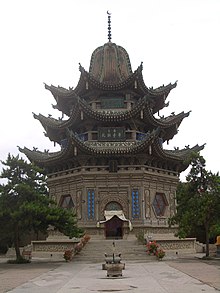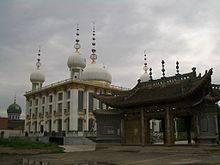Ma Laichi

| Part of a series on Islam in China |
|---|
 |
|
|
Ma Laichi (1681? – 1766?[1]), (Chinese: Chinese: 马来迟) also known as Abu 'l-Futūh Ma Laichi, was a Sufi master, who brought the Khufiyya movement to China and created the Huasi menhuan (Sufi order) - the earliest and most important Naqshbandi order in the history of Islam in China.[2][3]
Life
Afaq Khoja's blessing
Ma Laichi is a hybrid of Hui (Dungan) and Han Chinese. He came from a muslim family with a military background. His grandfather, Ma Congshan, was a general under the Ming Dynasty; his father, Ma Jiujun, passed imperial examinations on the military track under the Qing, but instead of joining government service, made a fortune in business and married a Chinese woman (she converted to Islam after marriage) later. His home was in Hezhou (now called Linxia), one of the main Muslim centers of Gansu.
According to the legend told by Ma Laichi's followers, Ma Jiajun was still childless at the age of forty, and, desirous to have a son, he went to Xining, to ask for a blessing from Afaq Khoja, a Naqshbandi shaykh visiting from Kashgar, and a reputed miracle worker. After reciting some prayers, the Kashgarian Sufi master told Ma Jiajun to go back to Hezhou and to marry a certain Chinese woman, who had previously been engaged a number of times, but every time her fiance died before the wedding. Ma Jiajun indeed married that 26-year-old woman, and she bore him a son. Soon after, all Ma Jiajun's property was destroyed by a fire, and he named his son "Laichi", meaning "[one who] came too late".[4]
Rendered destitute by the fire, Ma Jiajun became a tea peddler, travelling in the region between Hezhou and Xining. His boy, meanwhile, studied at the Koranic school run by Khoja Afaq's disciple Ma Tai Baba (马太爸爸, "The Great-grandfather Ma", 1632–1709) in the nearby Milagou (米拉沟).[3] (apparently, within today's Minhe Hui and Tu Autonomous County).
Tai Baba's top student, Ma Laichi had learned everything the school had to offer by the age of 18. Tai Baba ordained the young Ma as an akhund and initiated him into Sufism, passing onto him the barakah that he had received from Afaq Khoja.[3]
The great Hajj
According to Ma Tong's chronology of Ma Laichi's life, after 30 years of religious work in Hezhou region, Ma Laichi left China in 1728 for a Hajj to Islam's holy places in the Middle East. In 1728-1733 he studied under a number of Sufi masters in Arab World (primarily in Mecca and Yemen; some versions of his biography also mention Cairo and Damascus). Due to the scarcity and imprecision of existing Chinese and Arabic sources, different researchers came up with different versions and dates for Ma Laichi's great Hajj: the standard Chinese account by Ma Tong tells of Ma sailing to Arabia from Guangzhou (after studying for 3 months with a famous ahong there), and coming back by the sea route as well; other accounts have him traveling to the west overland, via Central Asia, and studying for a while in Bukhara. In Mecca, his teacher was the head of the Khafiya zawiya (Islamic school) there, Muhammad Jibuni Ahmad Agelai (or Ajilai, in other accounts). Another teacher who have influenced him greatly was Mawlana Makhdum, who gave Ma Laichi the name Abu 'l-Futūh. Not much is known about Makhdum, but Joseph Fletcher surmised that he may have been a Hindustani.[2][3]
The Khufiyya
After returning to China, Ma Laichi established the Hua Si (华寺; "Multicolored Mosque") school (menhuan) - the core of the Khufiyya movement in China. The name of the movement - a Chinese form of the Arabic "Khafiyya", i.e. "the silent ones" - refers to its adherents' emphasis on silent dhikr (invocation of God's name). The Khufiyya teachings were characterized by stronger participation in the society, as well as veneration of saints and seeking inspiration at their tombs.[2]
Ma Laichi spent 32 years spreading his teaching among the Hui (Dungan) and Salar people in Gansu and Qinghai. He had great success in the guidance and persuasion of numerous Tibetan, Mongol,[5] and Monguor-speaking communities in Qinghai to convert to Islam, sometimes after winning a religious debate with a local Tulku ("Living Buddha"). Some of these communities still belong to the Khufiyya, and their members still revere Ma Laichi as the saint who brought their ancestors into Islam.[2][3] His procedure in Dungan and Salar community, on the contrary, had been seriously challenged by Jahriyya. As a result of conflicts lasted for more than two centuries which destroyed the basis of Khufiyya in Dungan community, most of the members of Khufiyya are not Dungans or Salars (the Salars mostly turned to Al-Ikhwan since late 19th century).
Death

After the death of Ma Laichi, his position as the leader of the Khufiyya was inherited by his son, Ma Guobao - an act that came to be strongly criticized by the founder of the competing Jahriyya menhuan, Ma Mingxin.[6] Ma Guobao was later succeeded by Ma Wuyi.[7]
Ma Laichi's grave in Linxia City was restored in 1986. The shrine complex, which includes a mosque and is known as Hua Si Gongbei (华寺拱北), continues to be the center of the Hua Si Khufiyya menhuan.[2]
Literature
- Gladney, Dru C. (1996). Muslim Chinese: ethnic nationalism in the People's Republic. Volume 149 of Harvard East Asian monographs (2 ed.). Harvard Univ Asia Center. ISBN 0674594975. (First edition appeared in 1991).
- Lipman, Jonathan Neaman (1998). Familiar strangers: a history of Muslims in Northwest China. Hong Kong University Press. ISBN 9622094686.
- Weismann, Itzchak (2007). The Naqshbandiyya: orthodoxy and activism in a worldwide Sufi tradition. Volume 8 of Routledge Sufi series. Routledge. ISBN 041532243X.
References
- ^ As it is often the case with the 17th and 18th-century Hui Sufi figures, the chronology of Ma Laichi's life is not set firmly. Gladney (1996) (p. 47) gives no birth year, and 1766 as the death year; Weismann (2007) (p. 83), gives no birth year, and 1753 as the death year. Lipman (1998) does not give exact years for birth and death, and emphasizes differences between different historians' chronologies (p. 67); however, adding up lengths of time intervals in his biographical account implies that Ma would be close to 48 in 1728. The Great Chinese Encyclopedia (中国大百科全书, vol. 14 宗教 (Religion), p. 255) gives 1681-1766.
- ^ a b c d e Gladney (1996), pp. 47-48
- ^ a b c d e Lipman (1998), p. 65-67
- ^ Lipman (1998), p. 66. Lipman's telling of the story does not mention whether Ma Jiajun had been married already by the time of his asking for Afaq Khoja's help. One would imagine that he was already married or widowed, otherwise asking for divine intervention to get an heir would make little sense. Thus, it is not clear if he had other wives before, or simultaneously with, Ma Laichi's mother.
- ^ Probably, including the group known now as Bonan. (Lipman (1998), p. 65, citing Ma Tong).
- ^ Lipman (1998), p. 179
- ^ Lipman (1998), p. 111
| Part of a series on Islam Sufism |
|---|
 |
|
|
